Impact of Anthropogenic Threats on Species Diversity: A Case Study of the Sub-Himalayan Tropical Dry Deciduous Forests of Pakistan
Abstract
1. Introduction
2. Materials and Methods
2.1. Study Area
2.2. Data Collection and Analysis
3. Results
3.1. Two-Way Indicator Species Analysis (ISA)
3.2. Species Area Curve (SAC)
3.3. Ordination Analysis of Vegetation and Ecological Gradients Using CANOCO
3.4. Anthropogenic Pressure and Regeneration Rate
4. Discussion
5. Conclusions
Author Contributions
Funding
Institutional Review Board Statement
Informed Consent Statement
Data Availability Statement
Acknowledgments
Conflicts of Interest
References
- Kayanja, F.; Byarugaba, D. Disappearing forests of Uganda: The way forward. Curr. Sci. 2001, 81, 936–947. [Google Scholar]
- Taye, F.A.; Folkersen, M.V.; Fleming, C.M.; Buckwell, A.; Mackey, B.; Diwakar, K.; Le, D.; Hasan, S.; Saint Ange, C. The economic values of global forest ecosystem services: A meta-analysis. Ecol. Econ. 2021, 189, 107145. [Google Scholar] [CrossRef]
- Isbell, F.; Calcagno, V.; Hector, A.; Connolly, J.; Harpole, W.S.; Reich, P.B.; Scherer-Lorenzen, M.; Schmid, B.; Tilman, D.; Van Ruijven, J. High plant diversity is needed to maintain ecosystem services. Nature 2011, 477, 199–202. [Google Scholar] [CrossRef]
- Ahmad, B.; Wang, Y.; Hao, J.; Liu, Y.; Bohnett, E.; Zhang, K. Optimizing stand structure for trade-offs between overstory timber production and understory plant diversity: A case-study of a larch plantation in northwest China. Land Degrad. Dev. 2018, 29, 2998–3008. [Google Scholar] [CrossRef]
- Ahmad, B.; Wang, Y.; Hao, J.; Liu, Y.; Bohnett, E.; Zhang, K. Optimizing stand structure for tradeoffs between overstory and understory vegetation biomass in a larch plantation of Liupan Mountains, Northwest China. For. Ecol. Manag. 2019, 443, 43–50. [Google Scholar] [CrossRef]
- Haines-Young, R.; Potschin, M. The links between biodiversity, ecosystem services and human well-being. Ecosyst. Ecol. A New Synth. 2010, 1, 110–139. [Google Scholar]
- Ahmad, B.; Wang, Y.; Hao, J.; Liu, Y.; Bohnett, E.; Zhang, K. Variation of carbon density components with overstory structure of larch plantations in northwest China and its implication for optimal forest management. For. Ecol. Manag. 2021, 496, 119399. [Google Scholar] [CrossRef]
- Ahmad, B.; Ali, A.; Rabbi, F.; Alam, N.; Siraj, M.; Mehmood, K.; Muhammad, M.W.; Ullah, S. Estimation of Wood Volume, Carbon Stock and Rotation Age in Subtropical Pine Forests of Malakand, Khyber Pakhtunkhwa. Pak. J. Bot. 2022, 54, 1821–1826. [Google Scholar] [CrossRef]
- FAO. Global forest resources assessment 2010: Main report. In FAO Forestry Paper 163; Food and Agriculture Organization of the United Nations: Rome, Italy, 2010. [Google Scholar]
- Bélanger, J.; Pilling, D. The State of the World’s Biodiversity for Food and Agriculture; Food and Agriculture Organization of the United Nations (FAO): Rome, Italy, 2019. [Google Scholar]
- Mallik, B. Saving the Forests: Ecology in Sarvodaya. In Legends in Gandhian Social Activism: Mira Behn and Sarala Behn; Springer Nature: Cham, Switzerland, 2022; pp. 301–392. [Google Scholar]
- Cronin, R.P.; Pandya, A. Exploiting Natural Resources: Growth, Instability, and Conflict in the Middle East and Asia; Henry, L., Ed.; Stimson Center: Washington, DC, USA, 2009. [Google Scholar]
- Joshi, P.; Singh, S.; Agarwal, S.; Roy, P. Forest cover assessment in western Himalayas, Himachal Pradesh using IRS 1C/1D WiFS data. Curr. Sci. 2001, 80, 941–947. [Google Scholar]
- Khan, S.M.; Sue, P.; Habib, A.; Hamayun, S.; Mushtaq, A.; Harper, D. Phyto-climatic gradient of vegetation and habitat specificity in the high elevation western Himalayas. Pak. J. Bot. 2013, 45, 223–230. [Google Scholar]
- Khan, S.M.; Page, S.E.; Ahmad, H.; Harper, D.M. Sustainable utilization and conservation of plant biodiversity in montane ecosystems: The western Himalayas as a case study. Ann. Bot. 2013, 112, 479–501. [Google Scholar] [CrossRef] [PubMed]
- Prabhakar, R.; Somanathan, E.; Mehta, B.S. How degraded are Himalayan forests? Curr. Sci. 2006, 91, 61–67. [Google Scholar]
- Shaheen, H.; Ullah, Z.; Khan, S.M.; Harper, D.M. Species composition and community structure of western Himalayan moist temperate forests in Kashmir. For. Ecol. Manag. 2012, 278, 138–145. [Google Scholar] [CrossRef]
- Champion, S.H.; Seth, S.K.; Khattak, G. Forest types of Pakistan. In Forest Types of Pakistan; Pakistan Forest Institute: Peshawar, Pakistan, 1965. [Google Scholar]
- Anjum, F.; Ahmad, M.; Shinwari, Z.K.; Zafar, M.; Sultana, S.; Majeed, S.; Usman, A.; Mir, A. Diversity of Invasive Alien Plants Species of Lesser Himalayas-Pakistan. Pak. J. Bot 2022, 54, 2391–2403. [Google Scholar] [CrossRef]
- Rajput, S.A. Beauty and Mystery of Gandhara Art. Res. A Res. J. Cult. Soc. 2018, 3, 1–12. [Google Scholar] [CrossRef]
- Sanchez-Azofeifa, A.; Powers, J.S.; Fernandes, G.W.; Quesada, M. Tropical Dry Forests in the Americas: Ecology, Conservation, and Management; CRC Press: Boca Raton, CA, USA, 2013. [Google Scholar]
- Brandeis, T.J.; Delaney, M.; Parresol, B.R.; Royer, L. Development of equations for predicting Puerto Rican subtropical dry forest biomass and volume. For. Ecol. Manag. 2006, 233, 133–142. [Google Scholar] [CrossRef]
- Ghimire, K.B.; Barraclough, S.L. Agricultural Expansion and Tropical Deforestation: Poverty, International Trade and Land Use; Routledge: Oxfordshire, UK, 2013. [Google Scholar]
- Barbier, E.B. Explaining agricultural land expansion and deforestation in developing countries. Am. J. Agric. Econ. 2004, 86, 1347–1353. [Google Scholar]
- Biondi, E. Phytosociology today: Methodological and conceptual evolution. Plant Biosyst.-Int. J. Deal. All Asp. Plant Biol. 2011, 145, 19–29. [Google Scholar] [CrossRef]
- Ewald, J. A critique for phytosociology. J. Veg. Sci. 2003, 14, 291–296. [Google Scholar] [CrossRef]
- Whittaker, R.J.; Willis, K.J.; Field, R. Scale and species richness: Towards a general, hierarchical theory of species diversity. J. Biogeogr. 2001, 28, 453–470. [Google Scholar]
- van der Maarel, E. Vegetation ecology—An overview. Veg. Ecol. 2005, 3, 1–51. [Google Scholar]
- Zedan, H. IUCN Red List of Threatened Species: A Global Species Assessment; Iucn: Gland, Switzerland, 2004. [Google Scholar]
- Zou, D.; He, Y.; Lin, Q.; Cui, G. Evaluation of the level of threat and protective classification of the vegetation of Makehe Forest in Sanjiangyuan Nature Reserve, west China. Front. For. China 2007, 2, 179–184. [Google Scholar] [CrossRef]
- Song, N.; Zhang, J. Multivariate analysis of the endangered medicinal species cercidiphyllum japonicum communities in the Shennongjia Reserve, central China. Cerne 2018, 24, 180–189. [Google Scholar] [CrossRef]
- Chahouki, M.A.Z. Classification and ordination methods as a tool for analyzing of plant communities. Multivar. Anal. Manag. Eng. Sci. 2013, 221. [Google Scholar] [CrossRef]
- Grandin, U. PC-ORD version 5: A user-friendly toolbox for ecologists. J. Veg. Sci. 2006, 17, 843–844. [Google Scholar] [CrossRef]
- Ter Braak, C.J.; Smilauer, P. CANOCO Reference Manual and Canodraw for Windows User’s Guide: Software for Canonical Community Ordination (Version 4.5); www.canoco.com: Ithaca, NY, USA, 2002. [Google Scholar]
- Gilliam, F.S.; Saunders, N.E. Making more sense of the order: A review of Canoco for Windows 4.5, PC-ORD version 4 and SYN-TAX 2000. J. Veg. Sci. 2003, 14, 297–304. [Google Scholar]
- Alam, N.; Shinwari, Z.; Ilyas, M.; Ullah, Z. Indigenous knowledge of medicinal plants of Chagharzai valley, District Buner, Pakistan. Pak. J. Bot. 2011, 43, 773–780. [Google Scholar]
- Brower, J.E.; Zar, J.H.; Von Ende, C.N. Field and Laboratory Methods for General Ecology; WCB McGraw-Hill: Boston, MA, USA, 1998; Volume 4. [Google Scholar]
- Garden, M.B. Flora of Pakistan. 2011. Available online: http://www.tropicos.org/Project/Pakistan (accessed on 1 December 2022).
- Nath, T.K.; Jashimuddin, M.; Kamruzzaman, M.; Mazumder, V.; Hasan, M.K.; Das, S.; Dhali, P.K. Phytosociological characteristics and diversity of trees in a comanaged protected area of Bangladesh: Implications for conservation. J. Sustain. For. 2016, 35, 562–577. [Google Scholar] [CrossRef]
- Lomolino, M.V. The species-area relationship: New challenges for an old pattern. Prog. Phys. Geogr. 2001, 25, 1–21. [Google Scholar]
- Benjaminsen, T.A. Fuelwood and desertification: Sahel orthodoxies discussed on the basis of field data from the Gourma region in Mali. Geoforum 1993, 24, 397–409. [Google Scholar] [CrossRef]
- Fox, J. Firewood consumption in a Nepali village. Environ. Manag. 1984, 8, 243–249. [Google Scholar]
- Sanjay, G. Forest vegetation patterns along an altitudinal gradient in sub-alpine zone of west Himalaya, India. Afr. J. Plant Sci. 2008, 2, 42–48. [Google Scholar]
- Timilsina, N.; Ross, M.S.; Heinen, J.T. A community analysis of sal (Shorea robusta) forests in the western Terai of Nepal. For. Ecol. Manag. 2007, 241, 223–234. [Google Scholar] [CrossRef]
- De Cáceres, M.; Wiser, S.K. Towards consistency in vegetation classification. J. Veg. Sci. 2012, 23, 387–393. [Google Scholar] [CrossRef]
- Marimon, B.; Felfili, J.; Lima, E. Floristics and phytosociology of the gallery forest of the Bacaba Stream, Nova Xavantina, Mato Grosso, Brazil. Edinb. J. Bot. 2002, 59, 303–318. [Google Scholar] [CrossRef]
- Sagar, R.; Singh, J. Structure, diversity, and regeneration of tropical dry deciduous forest of northern India. Biodivers. Conserv. 2005, 14, 935–959. [Google Scholar] [CrossRef]
- Kumar, M.; Bhatt, V. Plant biodiversity and conservation of forests in foot hills of Garhwal Himalaya. J. Ecol. Appl. 2006, 11, 43–59. [Google Scholar]
- Parejiya, N.; Detroja, S.; Panchal, N. Vegetation analysis at Bandiyabedi Forest in Surendranagar district of Gujarat state of India. Int. J. Life Sci. Biotechnol. Pharm. Res. 2013, 2, 241–247. [Google Scholar]
- Luken, J.O. Directing Ecological Succession; Springer Science & Business Media: Berlin, Germany, 1990. [Google Scholar]
- Barbour, M.G.; Burk, J.H.; Pitts, W.D. Terrestrial Plant Ecology; Benjamin/Cummings: San Francisco, CA, USA, 1980. [Google Scholar]
- Beg, A.; Bakhsh, I. Vegetation on the scree slope of Chitral Gol. Pak. J. For. 1974, 24, 393–402. [Google Scholar]
- Khan, S.M.; Page, S.; Ahmad, H.; Harper, D. Ethno-ecological importance of plant biodiversity in mountain ecosystems with special emphasis on indicator species of a Himalayan Valley in the northern Pakistan. Ecol. Indic. 2014, 37, 175–185. [Google Scholar] [CrossRef]
- Khan, S.M.; Harper, D.; Page, S.; Ahmad, H. Species and community diversity of vascular flora along environmental gradient in Naran Valley: A multivariate approach through indicator species analysis. Pak. J. Bot. 2011, 43, 2337–2346. [Google Scholar]
- Chawla, A.; Rajkumar, S.; Singh, K.; Lal, B.; Singh, R.; Thukral, A. Plant species diversity along an altitudinal gradient of Bhabha Valley in western Himalaya. J. Mt. Sci. 2008, 5, 157–177. [Google Scholar] [CrossRef]
- Sanhueza, D.; Miranda, M.; Gómez, M.; Bonacic, C. Species richness, diversity and human activities in an elevation gradient of a high-ecosystem in Lagunas Huascoaltinas, Atacama Region, Chile. Cienc. E Investig. Agrar. Rev. Latinoam. Cienc. Agric. 2009, 36, 411–424. [Google Scholar] [CrossRef]
- Jennings, M.D.; Faber-Langendoen, D.; Loucks, O.L.; Peet, R.K.; Roberts, D. Standards for associations and alliances of the US National Vegetation Classification. Ecol. Monogr. 2009, 79, 173–199. [Google Scholar] [CrossRef]
- Sharma, C.; Baduni, N. Effect of aspect on the structure of some natural stands of Abies pindrow in Himalayan moist temperate forest. Environmentalist 2000, 20, 309–317. [Google Scholar]
- Dawes, W.R.; Short, D. The significance of topology for modeling the surface hydrology of fluvial landscapes. Water Resour. Res. 1994, 30, 1045–1055. [Google Scholar]
- Khan, N.; Shaukat, S.S.; Ahmed, M.; Siddiqui, M.F. Vegetation-environment relationships in the forests of Chitral district Hindukush range of Pakistan. J. For. Res. 2013, 24, 205–216. [Google Scholar] [CrossRef]
- Song, C.-Y.; Liu, G.-H.; Liu, Q.-S. Spatial and environmental effects on plant communities in the Yellow River Delta, Eastern China. J. For. Res. 2009, 20, 117–122. [Google Scholar] [CrossRef]
- Khafagi, A.; Sharaf, A.; Hatab, E.; Moursy, M. Vegetation composition and ecological gradients in Saint Katherine Mountain, South Sinai, Egypt. Am.-Eur. J. Agric. Environ. Sci. 2013, 13, 402–414. [Google Scholar]
- Titshall, L.; O’Connor, T.; Morris, C. Effect of long-term exclusion of fire and herbivory on the soils and vegetation of sour grassland. Afr. J. Range Forage Sci. 2000, 17, 70–80. [Google Scholar] [CrossRef]
- Day, F.P.; Monk, C.D. Vegetation patterns on a southern Appalachian watershed. Ecology 1974, 55, 1064–1074. [Google Scholar]
- Wang, X.; Zhang, B.; Zhang, K.; Zhou, J.; Ahmad, B. The spatial pattern and interactions of woody plants on the temperate savanna of Inner Mongolia, China: The effects of alternating seasonal grazing-mowing regimes. PLoS ONE 2015, 10, e0133277. [Google Scholar] [CrossRef]
- Liu, X.; Zhang, K.; Ahmad, B. Influence of fencing time on vegetation community structure and species diversity in sandy grassland of Ningxia in China. Nat. Environ. Pollut. Technol. 2015, 14, 703. [Google Scholar]
- Johnson, J.B. Stand structure and vegetation dynamics of a subalpine wooded fen in Rocky Mountain National Park, Colorado. J. Veg. Sci. 1997, 8, 337–342. [Google Scholar] [CrossRef]
- Busing, R.; White, P.; MacKenzie, M. Gradient analysis of old spruce—Fir forests of the Great Smoky Mountains circa 1935. Can. J. Bot. 1993, 71, 951–958. [Google Scholar]
- Bhatt, B.; Negi, A.; Todaria, N. Fuelwood consumption pattern at different altitudes in Garhwal Himalaya. Energy 1994, 19, 465–468. [Google Scholar]
- Sharma, A.; Uniyal, S.K.; Batish, D.R.; Singh, H.P. Utilization of fuelwood species by the Bhangalis community of western Himalaya, India. Environ. Dev. Sustain. 2022, 1–23. [Google Scholar] [CrossRef]
- Ahmad, Z.; Ali, Z.; Ghani, F.; Khalid, S. Regeneration of Natural Forests in the Hindu Kush Range: A Case Study of Quercus baloot Plants in Sheshikoh Oak Forests, District Chitral, Pakistan. Int. J. For. Res. 2022, 2022. [Google Scholar] [CrossRef]
- Shaheen, H.; Mushtaq, A.; Khan, R.W.A.; Azad, B. Fuelwood consumption pattern and its impact on forest structure in Kashmir Himalayas. Bosque 2016, 37, 419–424. [Google Scholar] [CrossRef]
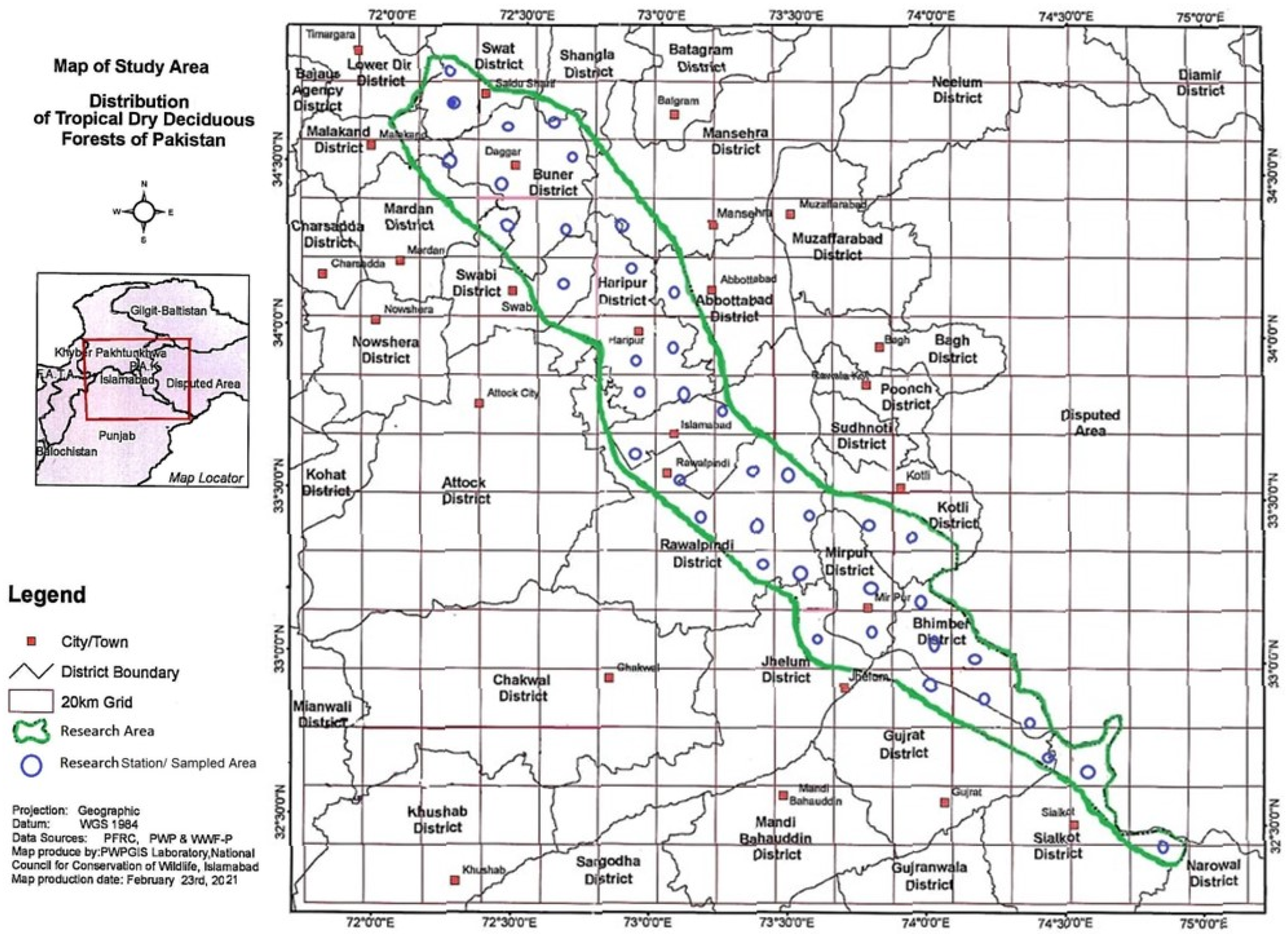
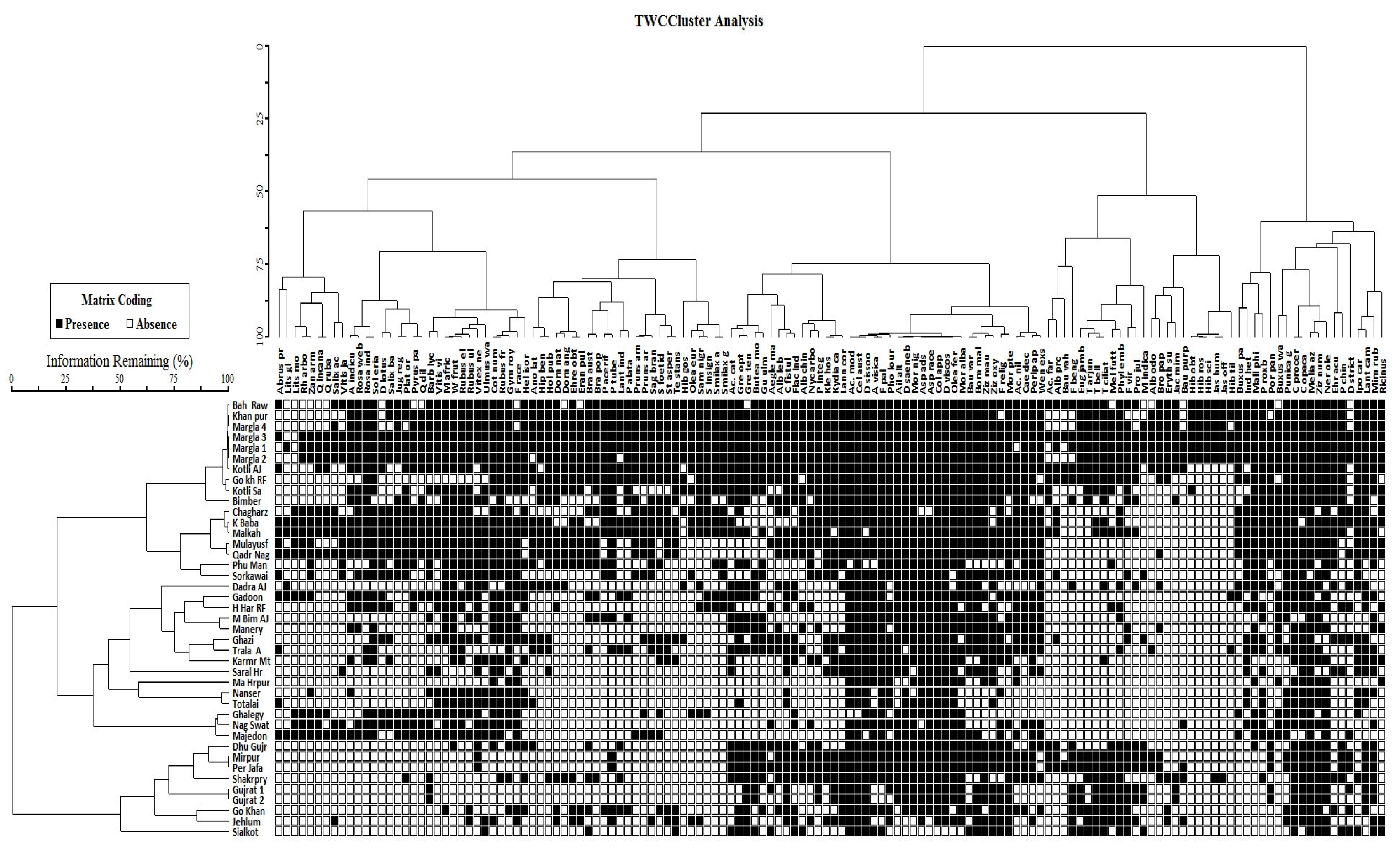

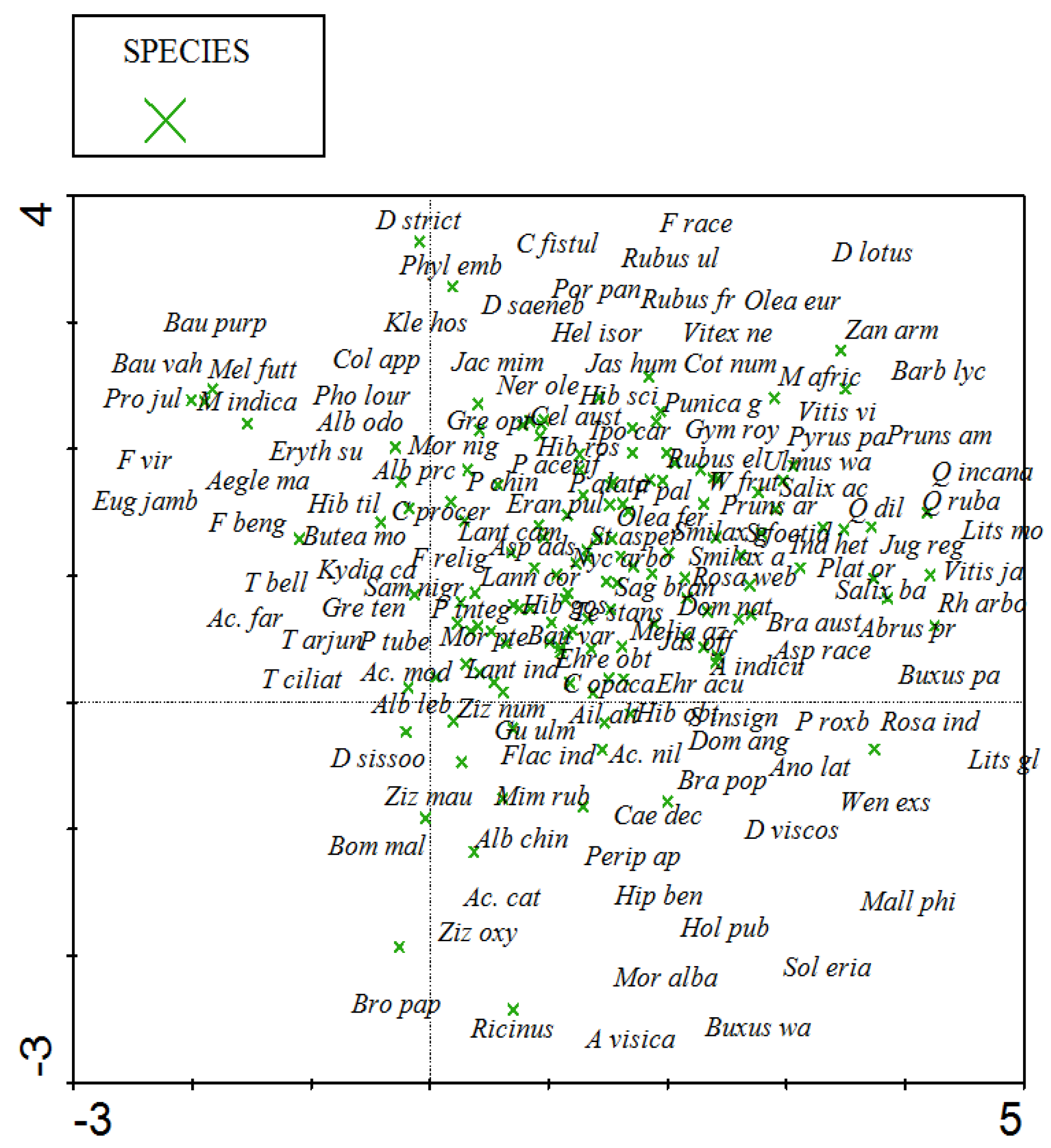

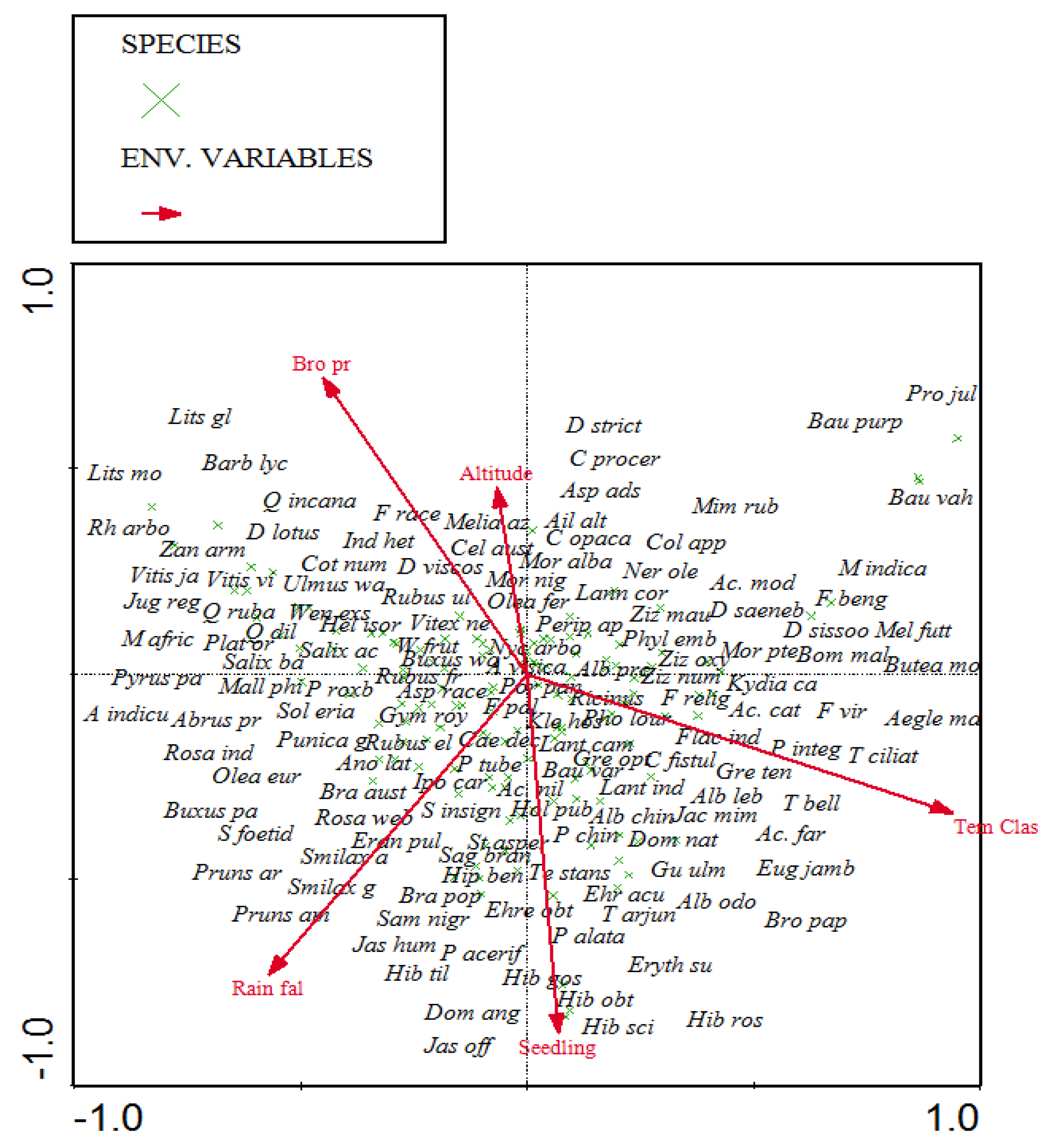
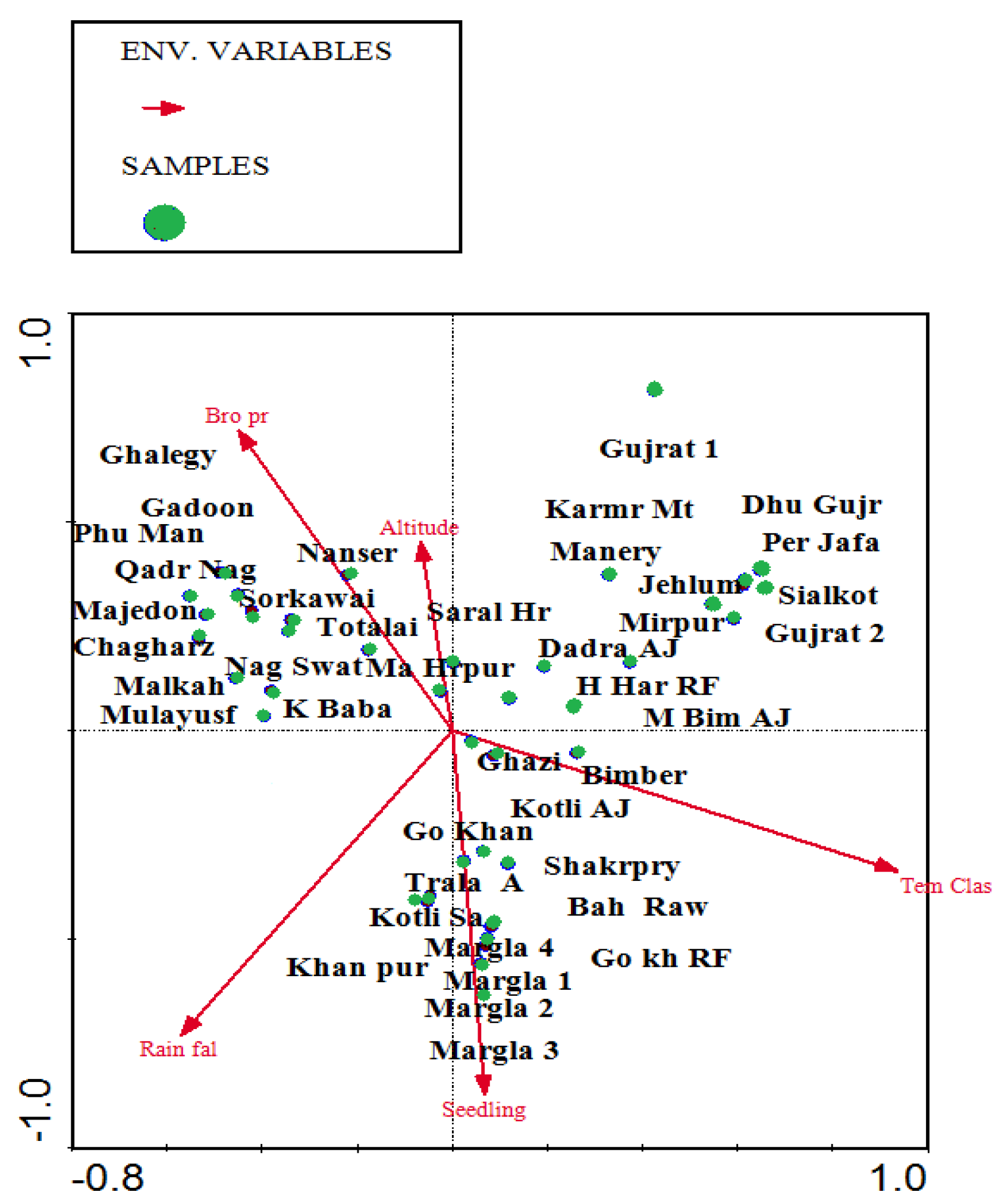
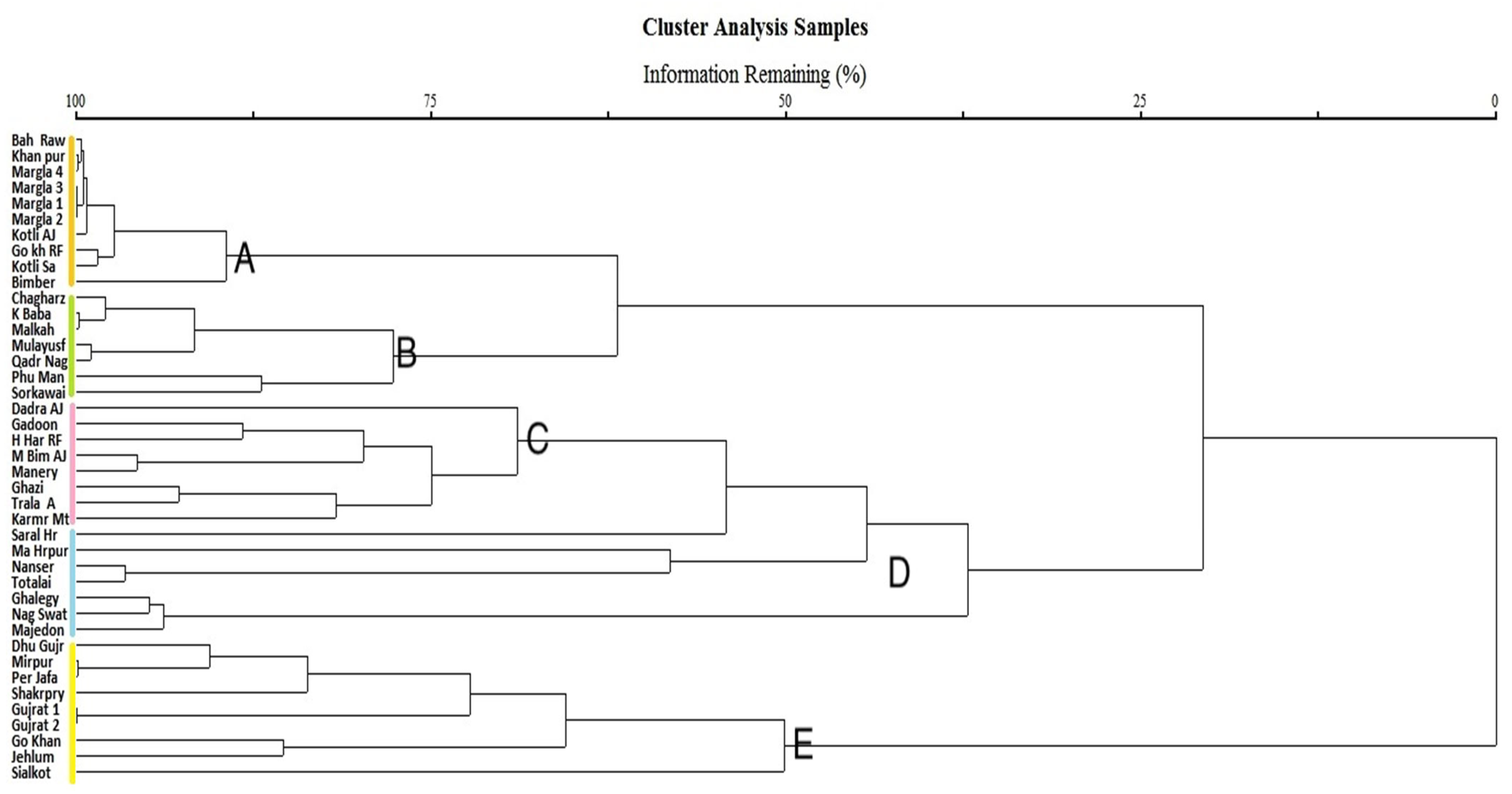
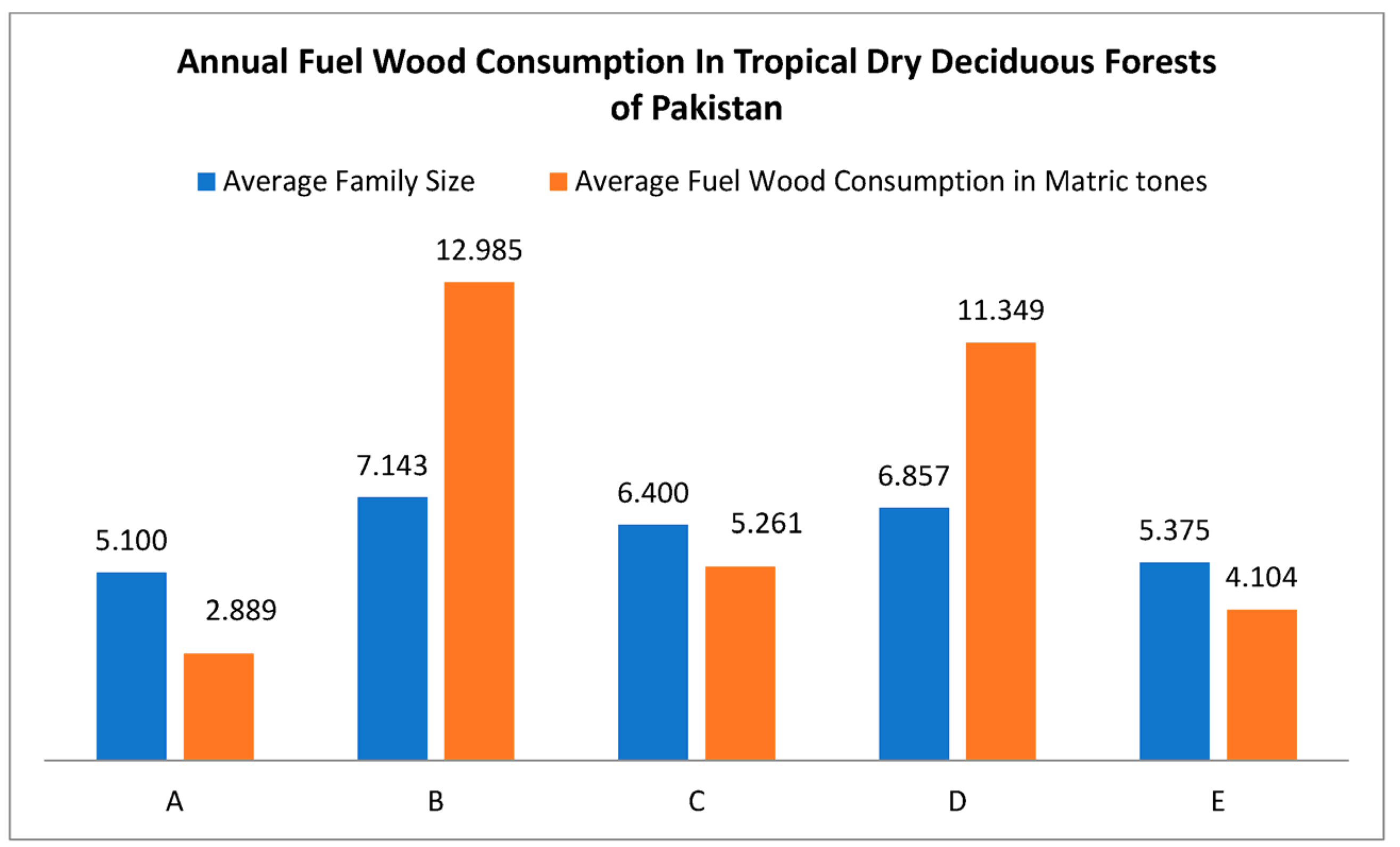
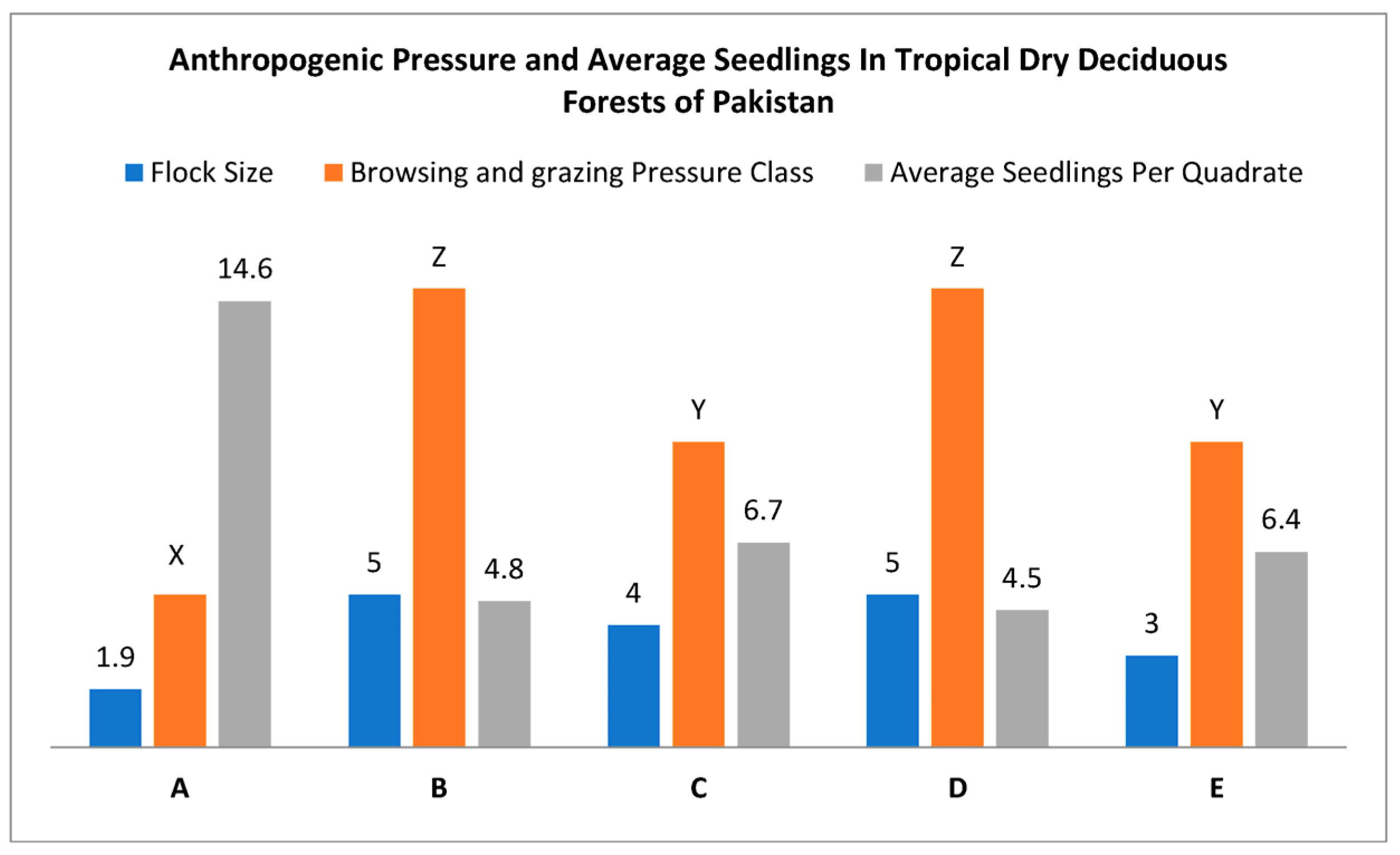
| Species Name | F | D | C | R. F. | R. D. | R. C. | IVI |
|---|---|---|---|---|---|---|---|
| Acacia modesta Wall | 132.8 | 22.9 | 14.7 | 128.9 | 112.5 | 232.3 | 473.7 |
| Adhatoda visica L. | 114.6 | 41.7 | 3.6 | 111.7 | 107.3 | 57.5 | 276.4 |
| Ailanthus altissima (Mill.) Swingle | 56.6 | 3.7 | 5.3 | 55.1 | 52.0 | 77.7 | 184.7 |
| Asparagus adscendens Roxb. | 80.1 | 10.1 | 1.7 | 77.7 | 75.0 | 27.6 | 180.3 |
| Asparagus racemosus Willd. | 66.8 | 6.9 | 1.4 | 64.5 | 59.6 | 20.1 | 144.2 |
| Calotropis procera (Ait.) Ait. | 53.5 | 0.4 | 1.6 | 52.2 | 42.3 | 26.3 | 120.9 |
| Celtis australis L. | 89.9 | 10.1 | 6.7 | 87.1 | 79.2 | 98.0 | 264.2 |
| Colebrookia appositifolia Smith | 56.8 | 6.7 | 1.6 | 55.0 | 45.0 | 25.3 | 125.3 |
| Dalbergia sissoo Roxb. | 90.8 | 0.8 | 9.9 | 88.4 | 90.2 | 164.8 | 343.4 |
| Debregeasia saeneb F. | 41.2 | 3.4 | 1.4 | 39.7 | 31.7 | 21.7 | 93.2 |
| Dodonaea viscosa Jacq. | 231.4 | 137.5 | 12.5 | 225.3 | 306.7 | 183.9 | 715.9 |
| Dombeya natalensis Sond | 9.8 | 0.1 | 0.5 | 9.6 | 6.6 | 6.4 | 22.6 |
| Ficus palmata Forssk | 64.0 | 25.5 | 5.2 | 61.8 | 48.5 | 74.4 | 184.8 |
| Melia azedarach L | 70.7 | 13.0 | 5.8 | 68.9 | 53.4 | 85.4 | 207.7 |
| Morus alba L. | 53.9 | 12.9 | 3.7 | 52.8 | 40.2 | 55.0 | 148.0 |
| Morus nigra L. | 39.7 | 6.6 | 3.4 | 38.7 | 34.1 | 53.8 | 126.7 |
| Nerium oleander Linn | 61.8 | 19.3 | 2.2 | 60.1 | 49.9 | 33.0 | 143.0 |
| Olea ferruginea Royle | 116.2 | 60.4 | 7.6 | 112.8 | 100.7 | 114.3 | 327.9 |
| Phoenix loureirii Kunth Enum | 23.8 | 0.2 | 2.5 | 23.0 | 20.7 | 36.6 | 80.3 |
| Ziziphus nummularia Wight & Arn | 126.6 | 1.0 | 3.9 | 123.1 | 99.5 | 63.9 | 286.5 |
| Axes | 1 | 2 | 3 | 4 | Total Inertia |
|---|---|---|---|---|---|
| Eigenvalues | 0.237 | 0.108 | 0.055 | 0.038 | 1.404 |
| Lengths of gradient | 2.558 | 2.239 | 1.692 | 1.203 | |
| Cumulative percentages of variance of species data | 16.9 | 24.6 | 28.5 | 31.2 |
| Axes | 1 | 2 | 3 | 4 | Total Inertia |
|---|---|---|---|---|---|
| Eigenvalues | 0.198 | 0.071 | 0.049 | 0.033 | 1.404 |
| Species–environment correlations | 0.926 | 0.867 | 0.764 | 0.733 | |
| Cumulative percentages of variance of species data | 14.1 | 19.2 | 22.7 | 25 | |
| Species–environment relationships | 52.4 | 71.1 | 84 | 92.7 |
| Test of significance of first canonical axis | |
| Eigenvalue | 0.198 |
| F-ratio | 5.759 |
| p-value | 0.002 |
| Test of significance of all canonical axes | |
| Trace | 0.379 |
| F-ratio | 2.587 |
| p-value | 0.002 |
Disclaimer/Publisher’s Note: The statements, opinions and data contained in all publications are solely those of the individual author(s) and contributor(s) and not of MDPI and/or the editor(s). MDPI and/or the editor(s) disclaim responsibility for any injury to people or property resulting from any ideas, methods, instructions or products referred to in the content. |
© 2023 by the authors. Licensee MDPI, Basel, Switzerland. This article is an open access article distributed under the terms and conditions of the Creative Commons Attribution (CC BY) license (https://creativecommons.org/licenses/by/4.0/).
Share and Cite
Alam, N.; Bohnett, E.; Zafar, M.; Sher, H.; Ahmad, B.; Ramadan, M.F.; Ahmad, M.; Ullah, Z.; Ali, A.; Khan, S.M.; et al. Impact of Anthropogenic Threats on Species Diversity: A Case Study of the Sub-Himalayan Tropical Dry Deciduous Forests of Pakistan. Sustainability 2023, 15, 2829. https://doi.org/10.3390/su15032829
Alam N, Bohnett E, Zafar M, Sher H, Ahmad B, Ramadan MF, Ahmad M, Ullah Z, Ali A, Khan SM, et al. Impact of Anthropogenic Threats on Species Diversity: A Case Study of the Sub-Himalayan Tropical Dry Deciduous Forests of Pakistan. Sustainability. 2023; 15(3):2829. https://doi.org/10.3390/su15032829
Chicago/Turabian StyleAlam, Naveed, Eve Bohnett, Muhammad Zafar, Hassan Sher, Bilal Ahmad, Mohamed Fawzy Ramadan, Mushtaq Ahmad, Zahid Ullah, Ahmad Ali, Shujaul Mulk Khan, and et al. 2023. "Impact of Anthropogenic Threats on Species Diversity: A Case Study of the Sub-Himalayan Tropical Dry Deciduous Forests of Pakistan" Sustainability 15, no. 3: 2829. https://doi.org/10.3390/su15032829
APA StyleAlam, N., Bohnett, E., Zafar, M., Sher, H., Ahmad, B., Ramadan, M. F., Ahmad, M., Ullah, Z., Ali, A., Khan, S. M., & Syed, K. (2023). Impact of Anthropogenic Threats on Species Diversity: A Case Study of the Sub-Himalayan Tropical Dry Deciduous Forests of Pakistan. Sustainability, 15(3), 2829. https://doi.org/10.3390/su15032829










